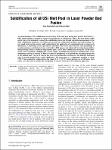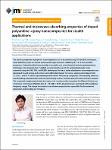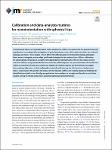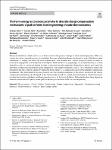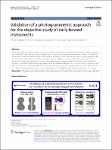Search
Author
- Manyk, T. (3)
- Murawski, K. (3)
- Baumgartner, Jörg (2)
- Guizani, Chamseddine (2)
- next >
Subject
Date issued
- 2023 (187)
Has File(s)
- true (187)
Search Results
Advanced soft ion-conducting hydrogels have been developed rapidly in the integrated portable health monitoring equipment due to their higher sensitivity, sensory traits, tunable conductivity, and stretchability for physiological activities and personal healthcare detection. However, traditional hydrogel conductors are normally susceptible to large deformation and strong mechanical stress, which leads to inferior electro-mechanical stability for real application scenarios. Herein, a strong ionically conductive hydrogel (poly(vinyl alcohol)-boric acid-glycerol/sodium alginate-calcium chloride/electrolyte ions (PBG/SC/EI)) was designed by engineering the covalently and ionically crosslinked networks followed by the salting-out effect to further enhance the mechanical strength and ioni... |
Realizing application specific manufacture with fusion-based additive manufacturing (F-BAM) processes requires understanding of the physical phenomena that drive evolution of microstructural attributes, such as texture. Current approaches for understanding texture evolution in F-BAM are majorly considerate of the phenomena occurring only during solidification. This hinders the comprehensive understanding and control of texture during F-BAM. In this perspective article, we discuss several physical phenomena occurring during and after solidification that can determine texture in F-BAM processed stainless steels (SS). A crystal plasticity-coupled hydrogen adsorption-diffusion modeling framework is also leveraged to demonstrate the prospects of grain boundary engineering with F-BAM for ... |
An understanding of the solidification characteristics of the melt pool during laser powder bed fusion, L-PBF, metal printing is essential to ensure the manufacture of sound parts. This is the main theme of this article where it is attempted to unlock the solidification black box through calculation/measurement of the main solidification parameters of cooling rate, growth rate, temperature gradient, and undercooling. The very small melt pool size and its rapid cooling hinder the application of conventional tools to extract such information. A knowledge of these parameters and their effect on the microstructure and morphology of constituent phases could help to better control the L-PBF process and indeed all the fusion-based additive manufacturing routes, to fabricate high-quality pa... |
Changes in precipitation, temperature and humidity can lead to the weathering of rock masses in grottoes; these changes are common in sandstone grottoes. To simulate this cyclic process, different salt solutions were designed according to the main precipitated components. Sandstone specimens taken from Longshan Grottoes were soaked in these solutions for 48 h and then placed in a simulated environment with temperature and humidity changes for 5 cycles (50 h) to study the effects of hydrochemical, temperature and humidity changes on the sandstone. Physical indexes, such as mass, wave velocity, surface hardness and tensile strength, of the rock samples were measured every three cycles, and the damage characteristics and mechanisms of the sandstone were discussed based on SEM and XRD t... |
The thermal properties of polymeric nanocomposites can be examined using TGA and DSC techniques, while dielectric properties can be examined through simulated scattering (S11, S12, S21, and S22) parameters. Polyaniline (PAni) nanopowder was synthesized using chemical oxidative polymerization techniques. Consequently, the crystallite size and morphology of the synthesized powder were examined using the XRD, TEM, and FESEM techniques. Further, a series of polymeric nanocomposites was developed via wet mixing and compressor molding techniques for various volume percentages (54.0, 57.5, 60.1, and 61.7 vol%) of synthesized powder within PAni/epoxy composites. Consequently, dielectric and absorbing properties have been measured using a vector network analyzer and its software module. The ... |
Instrumented spherical nanoindentation with a continuous stiffness measurement has gained increased popularity in microphysical investigations of grain boundaries, twins, dislocation densities, ion-induced damage, and more. These studies rely on different methodologies for instrument and tip calibration. Here, we test, integrate, and re-adapt published strategies for tip and machine-stiffness calibration for spherical tips. We propose a routine for independently calibrating the effective tip radius and the machine stiffness using standard reference materials, which requires the parametrization of the effective radius as a function of load. We validate our proposed workflow against key benchmarks and apply the resulting calibrations to data collected in materials with varying ductili... |
Chemical substitution, which can be iso- or heterovalent, is the primary strategy to tailor material properties. There are various ways how a material can react to substitution. Isovalent substitution changes the density of states while heterovalent substitution, i.e. doping, can induce electronic compensation, ionic compensation, valence changes of cations or anions, or result in the segregation or neutralization of the dopant. While all these can, in principle, occur simultaneously, it is often desirable to select a certain mechanism in order to determine material properties. Being able to predict and control the individual compensation mechanism should therefore be a key target of materials science. This contribution outlines the perspective that this could be achieved by taking ... |
Metal soaps, the organic salts resulting from the interaction of fatty acids and metal cations, arouse interest in the scientific field because of their versatility in a great range of chemical applications as well as because of the mechanism of their formation during degradation processes. This article presents a review of the synthetic pathways used to produce metal soaps, their relevant physico-chemical properties, and how these reflect in their applications. Common industrial uses of metal soaps are reported, with a particular focus on those applications, such as cosmetics, paints, and coatings, that have an impact on the cultural heritage field. In addition, the occurrence of metal soaps in cultural heritage studies is presented, ranging from archaeological and ethnographic art... |
Some early violins have been reduced during their history to fit imposed morphological standards, while more recent ones have been built directly to these standards. We propose an objective photogrammetric approach to differentiate between a reduced and an unreduced instrument, whereby a three-dimensional mesh is studied geometrically by examining 2D slices. Our contribution is twofold. First, we validate the quality of the photogrammetric mesh through a comparison with reference images obtained by medical imaging, and conclude that a sub-millimetre accuracy is achieved. Then, we show how quantitative and qualitative features such as contour lines, channel of minima and a measure of asymmetry between the upper and lower surfaces of a violin can be automatically extracted from the va... |
Adverse skin reactions caused by ionizing radiation are collectively called radiation dermatitis (RD), and the use of nanomedicine is an attractive approach to this condition. Therefore, we designed and large-scale synthesized fullerenols that showed free radical scavenging ability in vitro. Next, we pretreated X-ray-exposed cells with fullerenols. The results showed that pretreatment with fullerenols significantly scavenged intracellular reactive oxygen species (ROS) produced and enhanced the antioxidant capacity, protecting skin cells from X-ray-induced DNA damage and apoptosis. Moreover, we induced RD in mice by applying 30 Gy of X-ray irradiation, followed by treatment with fullerenols. We found that after treatment, the RD scores dropped, and the histological results systematic... |



